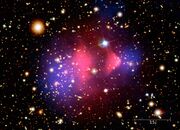Physics:Holeum
Holeums are hypothetical stable, quantized gravitational bound states of primordial or micro black holes. Holeums were proposed by L. K. Chavda and Abhijit Chavda in 2002.[1] They have all the properties associated with cold dark matter. Holeums are not black holes, even though they are made up of black holes.
Properties
The binding energy [math]\displaystyle{ E_{n} }[/math] of a holeum that consists of two identical micro black holes of mass [math]\displaystyle{ m }[/math] is given by[2]
- [math]\displaystyle{ E_{n}=-\frac{mc^{2}\alpha_{g}^{2}}{4n^{2}} }[/math]
in which [math]\displaystyle{ n }[/math] is the principal quantum number, [math]\displaystyle{ n=1,2,...,\infty }[/math] and [math]\displaystyle{ \alpha_{g} }[/math] is the gravitational counterpart of the fine structure constant. The latter is given by
- [math]\displaystyle{ \alpha_{g}=\frac{m^{2}G}{\hbar c}=\frac{m^{2}}{m_{P}^{2}} }[/math]
where:
- [math]\displaystyle{ \hbar }[/math] is the Planck constant divided by [math]\displaystyle{ 2\pi }[/math];
- [math]\displaystyle{ c }[/math] is the speed of light in vacuum;
- [math]\displaystyle{ G }[/math] is the gravitational constant.
The nth excited state of a holeum then has a mass that is given by
- [math]\displaystyle{ m_{H}=2m+\frac{E_{n}}{c^{2}} }[/math]
The holeum's atomic transitions cause it to emit gravitational radiation.
The radius of the nth excited state of a holeum is given by
- [math]\displaystyle{ r_{n}=\left( \frac{n^{2}R}{\alpha_{g}^{2}}\right) \left( \frac{\pi^{2}}{{8}}\right) }[/math]
where:
- [math]\displaystyle{ R=\left( \frac{2mG}{c^{2}}\right) }[/math] is the Schwarzschild radius of the two identical micro black holes that constitute the holeum.
The holeum is a stable particle. It is the gravitational analogue of the hydrogen atom. It occupies space. Although it is made up of black holes, it itself is not a black hole. As the holeum is a purely gravitational system, it emits only gravitational radiation and no electromagnetic radiation. The holeum can therefore be considered to be a dark matter particle.[3]
Macro holeums and their properties
A macro holeum is a quantized gravitational bound state of a large number of micro black holes. The energy eigenvalues of a macro holeum consisting of [math]\displaystyle{ k }[/math] identical micro black holes of mass [math]\displaystyle{ m }[/math] are given by[4]
- [math]\displaystyle{ E_{k}=-\frac{p^{2}mc^{2}}{2n_{k}^{2}}\left( 1-\frac{p^{2}}{6n^{2}}\right)^{2} }[/math]
where [math]\displaystyle{ p=k\alpha_{g} }[/math] and [math]\displaystyle{ k\gg2 }[/math]. The system is simplified by assuming that all the micro black holes in the core are in the same quantum state described by [math]\displaystyle{ n }[/math], and that the outermost, [math]\displaystyle{ k^{th} }[/math] micro black hole is in an arbitrary quantum state described by the principal quantum number [math]\displaystyle{ n_{k} }[/math].
The physical radius of the bound state is given by
- [math]\displaystyle{ r_{k}=\frac{\pi^{2}kRn_{k}^{2}}{16p^{2}\left( 1-\frac{p^{2}}{6n^{2}}\right)} }[/math]
The mass of the macro holeum is given by
- [math]\displaystyle{ M_{k}=mk\left( 1-\frac{p^{2}}{6n^{2}}\right) }[/math]
The Schwarzschild radius of the macro holeum is given by
- [math]\displaystyle{ R_{k}=kR\left( 1-\frac{p^{2}}{6n^{2}}\right) }[/math]
The entropy of the system is given by
- [math]\displaystyle{ S_{k}=k^{2}S\left( 1-\frac{p^{2}}{6n^{2}}\right) }[/math]
where [math]\displaystyle{ S }[/math] is the entropy of the individual micro black holes that constitute the macro holeum.
The ground state of macro holeums
The ground state of macro holeums is characterized by [math]\displaystyle{ n=\infty }[/math] and [math]\displaystyle{ n_{k}=1 }[/math]. The holeum has maximum binding energy, minimum physical radius, maximum Schwarzschild radius, maximum mass, and maximum entropy in this state.
Such a system can be thought of as consisting of a gas of [math]\displaystyle{ k-1 }[/math] free ([math]\displaystyle{ n=\infty }[/math]) micro black holes that is bounded and therefore isolated from the outside world by a solitary outermost micro black hole whose principal quantum number is [math]\displaystyle{ n_{k}=1 }[/math].
Stability
It can be seen from the above equations that the condition for the stability of holeums is given by
- [math]\displaystyle{ \frac{p^{2}}{6n^{2}}\lt 1 }[/math]
Substituting the relations [math]\displaystyle{ p=k\alpha _{g} }[/math] and [math]\displaystyle{ \alpha _{g}=\frac{m^{2}}{m_{P}^{2}} }[/math] into this inequality, the condition for the stability of holeums can be expressed as
- [math]\displaystyle{ m\lt m_{P}\left( 6\right) ^{\frac{1}{4}}\left( \frac{n}{k}\right) ^{\frac{1}{2}} }[/math]
The ground state of holeums is characterized by [math]\displaystyle{ n=\infty }[/math], which gives us [math]\displaystyle{ m\lt \infty }[/math] as the condition for stability. Thus, the ground state of holeums is guaranteed to be always stable.
Black holeums
A holeum is a black hole if its physical radius is less than or equal to its Schwarzschild radius, i.e. if
- [math]\displaystyle{ r_{k}\leqslant R_{k} }[/math]
Such holeums are termed black holeums. Substituting the expressions for [math]\displaystyle{ r_{k} }[/math] and [math]\displaystyle{ R_{k} }[/math], and simplifying, we obtain the condition for a holeum to be a black holeum to be
- [math]\displaystyle{ m\geqslant \frac{m_{P}}{2}\left( \frac{\pi n_{k}}{k}\right) ^{\frac{1}{2}} }[/math]
For the ground state, which is characterized by [math]\displaystyle{ n_{k}=1 }[/math], this reduces to
- [math]\displaystyle{ m\geqslant \frac{m_{P}}{2}\left( \frac{\pi}{k}\right) ^{\frac{1}{2}} }[/math]
Black holeums are an example of black holes with internal structure. Black holeums are quantum black holes whose internal structure can be fully predicted by means of the quantities [math]\displaystyle{ k }[/math], [math]\displaystyle{ m }[/math], [math]\displaystyle{ n }[/math], and [math]\displaystyle{ n_{k} }[/math].
Holeums and cosmology
Holeums are speculated to be the progenitors of a class of short duration gamma ray bursts.[5][6] It is also speculated that holeums give rise to cosmic rays of all energies, including ultra-high-energy cosmic rays.[7]
See also
- Micro black hole
- Black hole electron
- Planck particle
- Dark Matter
References
- ↑ L. K. Chavda & Abhijit Chavda, Dark matter and stable bound states of primordial black holes
- ↑ L. K. Chavda & Abhijit Chavda, Dark matter and stable bound states of primordial black holes
- ↑ M. Yu. Khlopov, Primordial Black Holes
- ↑ L. K. Chavda & Abhijit Chavda, Quantized Gravitational Radiation from Black Holes and other macro holeums in the Low Frequency Domain
- ↑ S. Al Dallal, Holeums as potential candidates for some short-lived gamma ray bursts
- ↑ S. Al Dallal, Primordial black holes and holeums as progenitors of galactic diffuse gamma-ray background
- ↑ L. K. Chavda & Abhijit Chavda, Ultra High Energy Cosmic Rays from decays of holeums in Galactic Halos
External links
- Acta Physica: Chronicles the development of the theory of holeums
- A Stable Holeum
- Gravitational Radiation from Holeums
- Constructing a Macro Holeum from the Inside Out
- The Black Holeum


